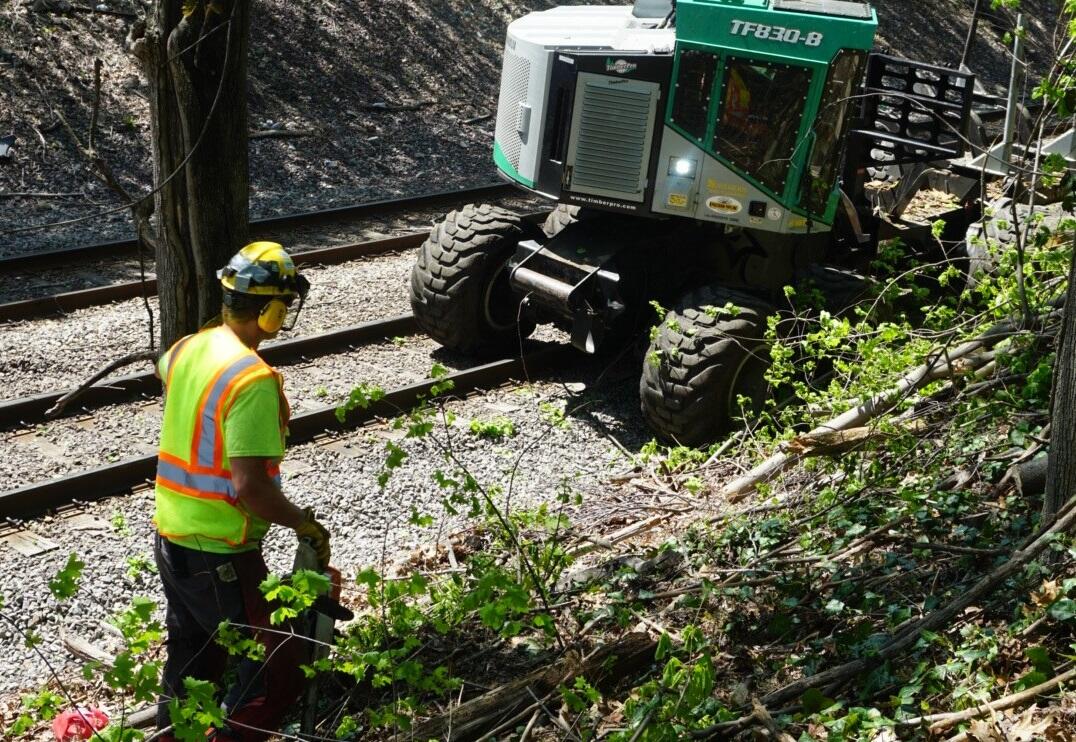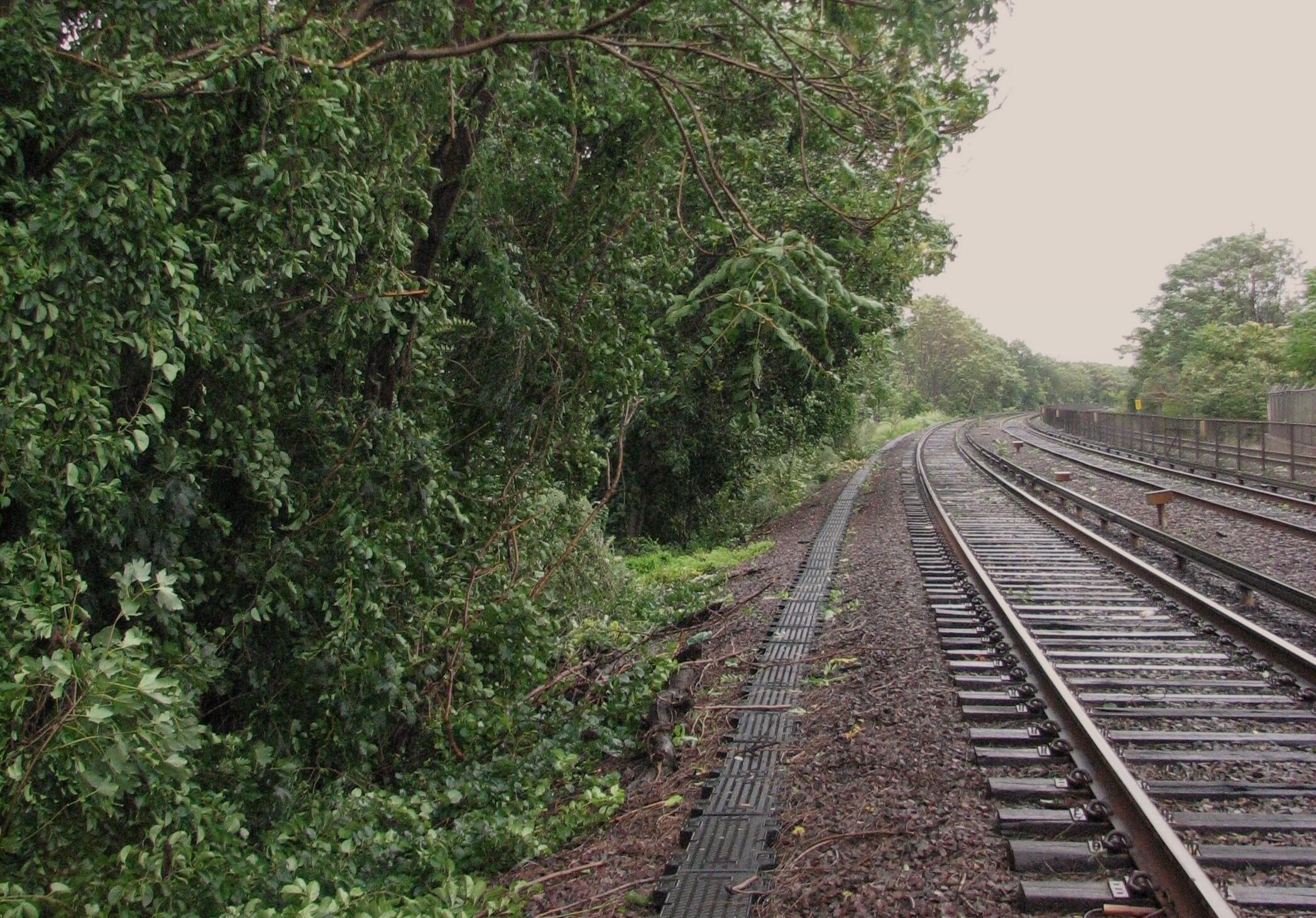Vegetation Management

Federal and state laws require transit systems to control vegetation that could interfere with rail safety.
The right of way (ROW) is a transportation corridor—vegetation on or near the ROW may be unsafe for riders and employees, can damage equipment, and could cause service delays.
Overgrown vegetation can obstruct the required line-of-sight along crossings and critical signal areas. In addition, natural hazards such as high winds, ice storms, and other inclement weather conditions increase the risk for vegetation and trees to break, fall, and create obstacles along transportation corridors.
To avoid these issues, the ROW requires both routine and emergency vegetation management.
Management Methods
The Vegetation Management Plan combines mechanical and chemical methods to manage, control, and remove vegetation along the ROW.
Mechanical cutting and/or removal is typically used on trees, branches, and large brush to address issues such as:
- Falling leaves from surrounding vegetation that could land on tracks creating a slippery residue. The slippery rail condition can cause trains to lose traction, impacting performance and causing delays.
- Overgrown vegetation that could block site lines and damage infrastructure
- Low-hanging trees that could damage moving and stationary trains, and create unsafe conditions for MBTA staff and customers
- Downed trees that could interfere with service by blocking the movement of trains and cause unsafe rail conditions
- Downed or low hanging trees that could take down or interfere with overhead catenary, signal, and communication systems. This can remove positive train control (PTC) and other integral safety and communication systems.
- Any vegetation and/or trees higher than 10 feet
Chemicals (such as herbicides) are used to prevent emerging vegetation from growing. They are used to eradicate:
- Vegetation along the roadbed where there is no feasible mechanical method of removal
- Low-lying weeds that could catch fire in hot and dry weather
- Vegetation that could interfere with integral signal and communications system, as part of federally mandated inspections and maintenance
- Vegetation in ditches adjacent to the roadbed that could interfere with proper drainage functions
Regulatory and Stakeholder Outreach

Vegetative management along the ROW, required at the state and federal level, is regulated by the Massachusetts Department of Agriculture Resources (DAR).
These regulations detail a process by which the railroad must obtain DAR approval for their means and methods to control vegetation within the ROW.
This includes preparation of:
- Describes the five-year Integrated Pest Management (IPM) program for managing vegetation in accordance with the requirements.
- Describes a variety of operational practices which include physical (mechanical cutting); chemical (herbicide application); and indirect methods used to manage, control, and eradicate vegetation on railroad ROWs.
- Addresses the major components of vegetation management including the rationale for the various techniques, buffering and protection of sensitive areas, application of Integrated Pest Management (IPM), and an overview of the railroad ROW system.
- Is subject to public review, published in the Environmental Monitor and reviewed by local officials, and DAR review and approval.
- Submitted annually to DAR for review and approval, with a Public Notice that is both published in the Environmental Monitor and shared with all concerned municipalities (Town Managers and Boards of Health) via certified mail.
- Addresses implementation approach for the year, including identification of the communities where vegetation management is planned.
Requests for Determination of Applicability (RDAs)
As part of the VMP process, Requests for Determination of Applicability (RDAs) are filed with each Conservation Commission.
RDAs provide maps to the Conservation Commissions and to the public. These maps show the ROW and any wetlands, waterways, drinking water wells, agricultural areas, etc. Those areas are defined as “no spray zones” in which herbicide application is prohibited.
The public is able to comment on these areas prior to certification by Conservation Commission. Keolis and the MBTA have previously agreed to expand the no spray zone to include areas such as playgrounds and parks at the request of communities.
Best Management Practices
During the VMP process, the MBTA and its contractors use Best Management Practices to reduce the impact on the environment and adjacent communities. These include:
- Accessing the work area via the right of way
- Properly disposing of cutting debris
- Leaving tree stumps in place to prevent erosion
- Monitoring weather and wind conditions to avoid herbicides drifting and spreading
Documentation
Learn more about the MBTA’s vegetation management strategy, view maps of our service areas, and get details about the herbicides we use in the documents below.
View the MBTA 2024 – 2028 Vegetation Management Plan
The MBTA’s VMP is also available on Massachusetts Department of Agriculture Rights of Way Vegetation Management.
View documents by year:
Building a Better T
As part of our $9.6 billion, 5-year capital investment plan, we're renovating stations, modernizing fare collection systems, upgrading services for our buses, subways, and ferries, and improving the accessibility of the entire system.
Building a Better T
As part of our $9.6 billion, 5-year capital investment plan, we're renovating stations, modernizing fare collection systems, upgrading services for our buses, subways, and ferries, and improving the accessibility of the entire system.
